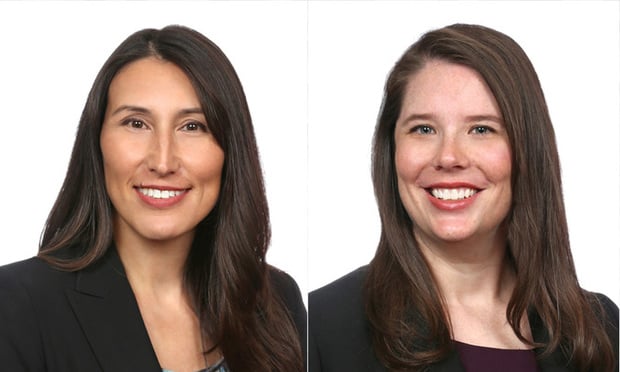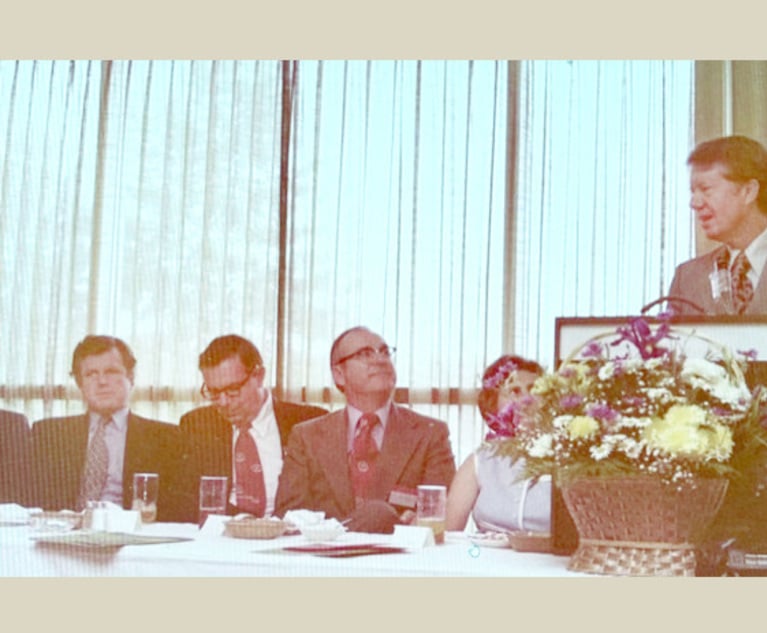Bringing Your Practice Into the 21st Century
Partnership agreements, engagement letters, fee contracts, legal malpractice insurance policies, calendar control systems, document retention policies and most other risk management tools that worked perfectly well a decade or two ago may no longer get the job done.
December 17, 2018 at 12:15 PM
6 minute read
 Shari Klevens (left) and Alanna Clair, Dentons. (Courtesy photo)
Shari Klevens (left) and Alanna Clair, Dentons. (Courtesy photo)
Inertia can be toxic to a law practice. Sometimes, lawyers are content to manage their practices as they always have, assuming that the old ways always work the best. However, state bars are beginning to hold attorneys accountable, imploring bar members to become more fluent or capable in recent technological aspects of the practice of law, such as cybersecurity or cloud computing.
Through the use of the internet and modern technology, attorneys can reach more people, accomplish more tasks and effectively monitor more matters than ever before. As the modern law practice has emerged, attorneys have seen the risks and frequency of legal malpractice claims change as they take full advantage of systems and solutions that actually reduce those risks.
Partnership agreements, engagement letters, fee contracts, legal malpractice insurance policies, calendar control systems, document retention policies and most other risk management tools that worked perfectly well a decade or two ago may no longer get the job done. In fact, some have been rendered obsolete, illegal, unethical or unenforceable.
Attorneys and law practices focused on 20th century solutions to 21st century challenges may face risks for which they are not prepared. To meet the requirements of today's demands—whether arising from changes in the ethics rules, legal authority or marketplace—an upgrade may be needed.
Although moving a practice from analog to digital can feel like a big undertaking, the truth is that there are many small steps that attorneys can consider to help them meet the new challenges of the modern law practice.
New Tools Help Prevent Malpractice
Certainly, changes in the modern law practice have created a new set of challenges for reducing the risks of a legal malpractice claim or bar grievance. These new challenges are ones that updated claim prevention systems can help address.
One helpful tool is to recognize the modern day law practice involves different challenges from past claims. Indeed, as malpractice claims evolve away from traditional allegations of ethical rule violations, it is helpful for lawyers to increase the overall security and modernity of their practice, rather than to try to operate within an older framework.
Because of these changes in risk dynamics, modern attorneys and law practices tend to focus more on claim prevention rather than malpractice prevention.
Updated Prevention Methods
Most firms have had malpractice prevention systems in place for years, if not decades. However, it is helpful for firms to update those practices and procedures underlying the systems to take advantage of developments in technology. For example, effective client intake procedures and conflict searches necessarily have changed as technology has evolved.
Indeed, an engagement letter or fee contract documenting the scope, nature, and obligations of the attorney-client relationship is an important part of every practice's client intake procedures. Thus, as law and technology have changed over the years, so too can engagement letters and fee contracts.
Many firms will periodically review and update their standard engagement letters to review and incorporate recent issues in the law, such as document retention, withdrawal, nonassignability, waivers and the right of termination, as well as a number of other issues unique to the practice area or the nature of the relationship. Computers make it easy to update form documents to include all of this information.
In another example, lawyers may use hard copy calendars or diaries to keep track of upcoming deadlines and events. However, the principles underlying the tracking of deadlines can be updated to include electronic docketing systems, which can help reduce the likelihood of a missed deadline or other administrative error. However, such systems typically only work as well as the information provided to them.
Further, most firms have time entry systems, but the market offers benefits that firms can use to cut down on their lawyers' ineffective time spent on nonbillable tasks. Automated time entry and billing have replaced old billing techniques like timeslips and repetitive time review with computer-generated pro formas, generally resulting in quicker and more accurate billing, fewer edits to the bill, faster review time and more reliable follow-up. Voicemail and email have made communication faster and more efficient, enabling greater responsiveness and better client communication.
Reviewing Contracts
Attorneys and firms can also review the protections they have in place to shield themselves from the risks associated with the practice of law, especially partnership agreements and legal malpractice insurance policies.
Firms can review their partnership agreements to ensure that they comply with recent developments in partnership law, liabilities, arbitration and other issues. Partnership agreements that have been in place for several decades may not anticipate the protections currently available to firms.
Separately from the potential developments at law, some firms may find that their partnership agreements do not accurately reflect the current state of the partnership, from its size to its number of partners to its risks, structures and liabilities.
Also, the legal malpractice insurance industry has changed in the last decade to identify cutting-edge risks and solutions for law firms. Regardless of whether a law practice is a high-risk practice with a substantial prior claims history or one that never has had a claim, there are more options than ever before. The challenge can be to explore the options and determine which coverage from which insurer offers the best option at the best price.
Some insurers offer real-time assistance with risk management issues, loss prevention, or malpractice concerns–but insured firms may not even be aware of all of the perks of their existing program. A firm that is not taking advantage of these developments may not be fully protecting itself.
Shari L. Klevens is a partner at Dentons US in Atlanta and Washington, D.C., and serves on the firm's U.S. board of directors. She represents and advises lawyers and insurers on complex claims and is co-chair of Dentons' global insurance sector team.
Alanna Clair, also a partner at Dentons US in Washington, focuses on professional liability and insurance defense. Klevens and Clair are co-authors of “The Lawyer's Handbook: Ethics Compliance and Claim Avoidance” and the upcoming 2019 edition of “Georgia Legal Malpractice Law.”
This content has been archived. It is available through our partners, LexisNexis® and Bloomberg Law.
To view this content, please continue to their sites.
Not a Lexis Subscriber?
Subscribe Now
Not a Bloomberg Law Subscriber?
Subscribe Now
NOT FOR REPRINT
© 2025 ALM Global, LLC, All Rights Reserved. Request academic re-use from www.copyright.com. All other uses, submit a request to [email protected]. For more information visit Asset & Logo Licensing.
You Might Like
View All


Jimmy Carter’s 1974 Law Day Speech: A Call for Lawyers to Do the Public Good
14 minute readTrending Stories
- 1'It's Not Going to Be Pretty': PayPal, Capital One Face Novel Class Actions Over 'Poaching' Commissions Owed Influencers
- 211th Circuit Rejects Trump's Emergency Request as DOJ Prepares to Release Special Counsel's Final Report
- 3Supreme Court Takes Up Challenge to ACA Task Force
- 4'Tragedy of Unspeakable Proportions:' Could Edison, DWP, Face Lawsuits Over LA Wildfires?
- 5Meta Pulls Plug on DEI Programs
Who Got The Work
Michael G. Bongiorno, Andrew Scott Dulberg and Elizabeth E. Driscoll from Wilmer Cutler Pickering Hale and Dorr have stepped in to represent Symbotic Inc., an A.I.-enabled technology platform that focuses on increasing supply chain efficiency, and other defendants in a pending shareholder derivative lawsuit. The case, filed Oct. 2 in Massachusetts District Court by the Brown Law Firm on behalf of Stephen Austen, accuses certain officers and directors of misleading investors in regard to Symbotic's potential for margin growth by failing to disclose that the company was not equipped to timely deploy its systems or manage expenses through project delays. The case, assigned to U.S. District Judge Nathaniel M. Gorton, is 1:24-cv-12522, Austen v. Cohen et al.
Who Got The Work
Edmund Polubinski and Marie Killmond of Davis Polk & Wardwell have entered appearances for data platform software development company MongoDB and other defendants in a pending shareholder derivative lawsuit. The action, filed Oct. 7 in New York Southern District Court by the Brown Law Firm, accuses the company's directors and/or officers of falsely expressing confidence in the company’s restructuring of its sales incentive plan and downplaying the severity of decreases in its upfront commitments. The case is 1:24-cv-07594, Roy v. Ittycheria et al.
Who Got The Work
Amy O. Bruchs and Kurt F. Ellison of Michael Best & Friedrich have entered appearances for Epic Systems Corp. in a pending employment discrimination lawsuit. The suit was filed Sept. 7 in Wisconsin Western District Court by Levine Eisberner LLC and Siri & Glimstad on behalf of a project manager who claims that he was wrongfully terminated after applying for a religious exemption to the defendant's COVID-19 vaccine mandate. The case, assigned to U.S. Magistrate Judge Anita Marie Boor, is 3:24-cv-00630, Secker, Nathan v. Epic Systems Corporation.
Who Got The Work
David X. Sullivan, Thomas J. Finn and Gregory A. Hall from McCarter & English have entered appearances for Sunrun Installation Services in a pending civil rights lawsuit. The complaint was filed Sept. 4 in Connecticut District Court by attorney Robert M. Berke on behalf of former employee George Edward Steins, who was arrested and charged with employing an unregistered home improvement salesperson. The complaint alleges that had Sunrun informed the Connecticut Department of Consumer Protection that the plaintiff's employment had ended in 2017 and that he no longer held Sunrun's home improvement contractor license, he would not have been hit with charges, which were dismissed in May 2024. The case, assigned to U.S. District Judge Jeffrey A. Meyer, is 3:24-cv-01423, Steins v. Sunrun, Inc. et al.
Who Got The Work
Greenberg Traurig shareholder Joshua L. Raskin has entered an appearance for boohoo.com UK Ltd. in a pending patent infringement lawsuit. The suit, filed Sept. 3 in Texas Eastern District Court by Rozier Hardt McDonough on behalf of Alto Dynamics, asserts five patents related to an online shopping platform. The case, assigned to U.S. District Judge Rodney Gilstrap, is 2:24-cv-00719, Alto Dynamics, LLC v. boohoo.com UK Limited.
Featured Firms
Law Offices of Gary Martin Hays & Associates, P.C.
(470) 294-1674
Law Offices of Mark E. Salomone
(857) 444-6468
Smith & Hassler
(713) 739-1250







